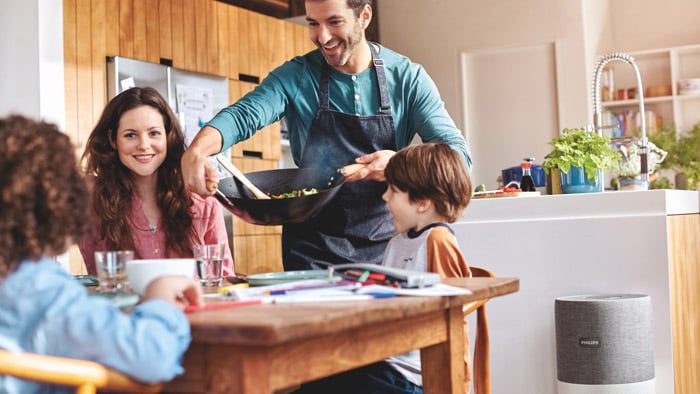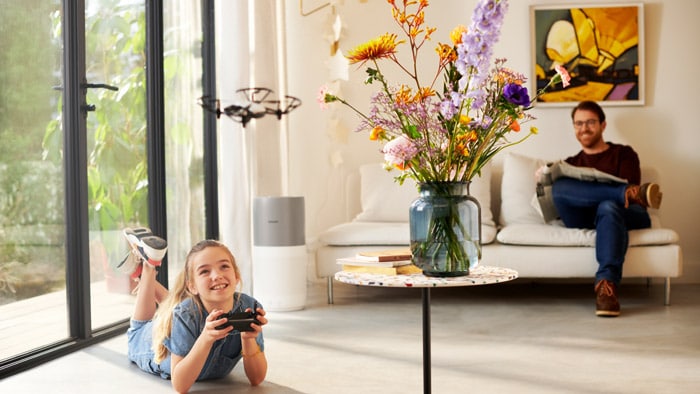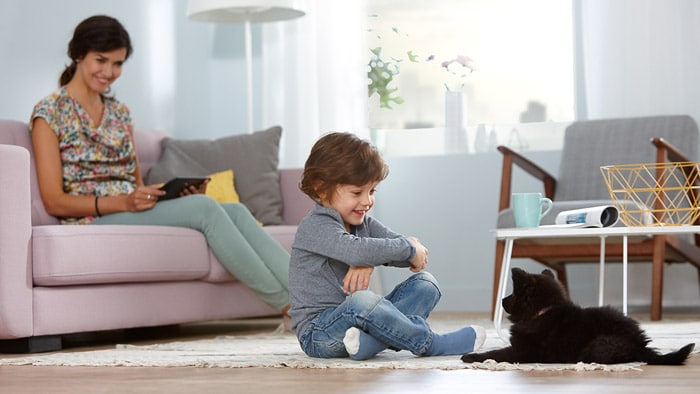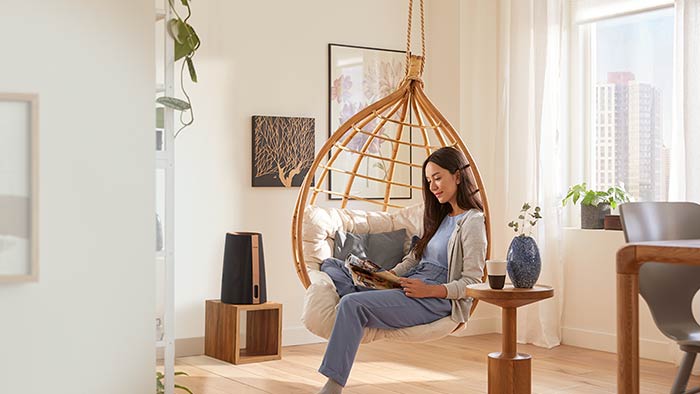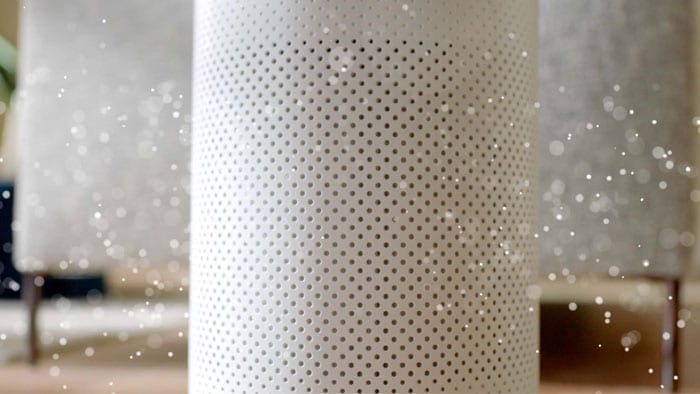Reading time: 4 Min
How effective is an air purifier and should you use one?
Air purifiers keep your home clean and fresh. They’re great for people with allergies and respiratory issues. They’re very effective at eliminating odours and improving the quality of the air in your living space.
Read on to find out what an air purifier does, whether you need one, and what to look out for when buying an air purifier.
What is an air purifier?
Air purifiers are electronic devices that remove contaminants like dust, pollen, and smoke to improve indoor air quality.
What does an air purifier do?
An air purifier works by drawing in indoor air and passing it through a filter.
The filter collects pollutants from the indoor environment and pushes clean air back into the room in its place.
Examples of pollutants removed by air purifiers include mould, pet hair and skin particles, radon, and carbon monoxide.
Another key benefit of air purifiers is that they also remove bad smells and cooking odours from where you live.
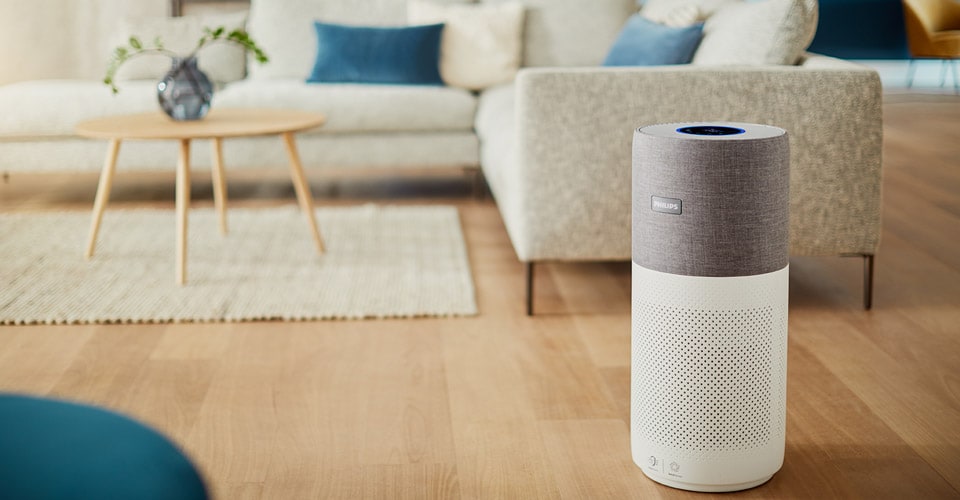
Air purifier uses
Air purifiers remove dust and other airborne pollutants very effectively.
As well as in homes, they're used by:
Key terms to know with your air purifier
We’ve put together this easy-to-use air purifier glossary to help you understand the important terms and concepts related to air purifiers.
Key technology in Philips Air Performer
The Philips Air Performer cleans, cools, and heats your home. It’s the most advanced Philips air purifier technology yet.
The Air Performer constantly monitors air quality in your home around the clock. Its smart built-in AI learns your usage patterns and automatically adjusts its settings to meet your family's needs.
This powerful new model cleans up to twice the volume of air than traditional high-efficiency particulate air (HEPA) H13 filters. That’s thanks to the electrostatic charges it uses to attract and trap pollutants.
The Air Purifier works effortlessly in large rooms up to 70 m2 in size. Its 350o adjustable airflow rotation cools you with a pleasant and natural airflow. When you need heat, you only have to wait three seconds for a blast of warmth thanks to its PTC ceramic technology.
In the bedroom, it’s whisper-silent in sleep mode, producing only 25 db(A) of noise. When you turn off your bedroom lights, the Air Performer's lights turn off too.
In auto mode, the energy-efficient design means that it only needs 40W to purify the air. That’s less than a traditional light bulb making it great for the environment and reducing your utility bills.
What you need
-
3000i Series
Air Purifier for XL Rooms
AC3033/30
- Purifies rooms up to 135 m²
- 520 m³/h clean air rate (CADR)
- HEPA & Active Carbon filter
- Connected with Air+ app
- Strictly tested for quality
-
- Purifies rooms up to 98 m²
- HEPA & Active Carbon filter
- 380 m³/h clean air rate (CADR)
- Connected with Air+ app
- Removes up to 99.9% of viruses and aerosols
-
- Works in rooms up to 78 ㎡
- 300 ㎥/h clean air rate (CADR)
- HEPA & Active carbon filter
- Connected with Air+ app
- Rigorously tested for quality
Do I Need One an air purifier?
There are many benefits to investing in an air purifier. Dust removal becomes much easier with an air purifier and you’ll soon notice how fresh the air feels and how much easier it is to breathe.
Getting an air purifier for allergy sufferers is a great idea. They reduce atmospheric pollen, pet hair and skin, and dust mites, providing much-needed relief from everyday allergen triggers.
Air purifiers help asthma sufferers too by removing dust and mould from your living space, making it much easier to breathe.
Also, with an air purifier, smoke and cooking smells are eliminated fast meaning your home smells fresh and clean.
You might also benefit from an air purifier if:
What to look out for when buying an air purifier
Choose the best model for your home by following these expert air purifier buying tips:
Other Easy Ways to Maintain the Best Air Quality at Home
If you want to improve air quality levels in your home but you’re not ready yet to buy a purifier, there are a number of ways you can do it.
Airing your home once a day is a great start.
When it’s really warm, this will get rid of excess moisture from inside your home and its rooms. When it’s colder, the fresh air will help stop damp and mould building.
When you’re cooking, having a bath, or doing the laundry, switch on your extractor fans. Switch them off a few minutes after you’re done.
You might also want to consider reducing or stopping the use of candles and log burners in your home. You could also ban smoking in your home to improve air quality.




